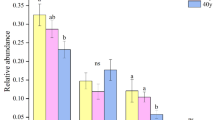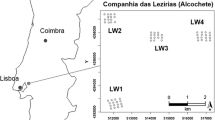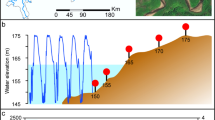Abstract
It has long been recognised that dispersal abilities and environmental factors are important in shaping invertebrate communities, but their relative importance for primary soil community assembly has not yet been disentangled. By studying soil communities along chronosequences on four recently emerged nunataks (ice-free land in glacial areas) in Iceland, we replicated environmental conditions spatially at various geographical distances. This allowed us to determine the underlying factors of primary community assembly with the help of metacommunity theories that predict different levels of dispersal constraints and effects of the local environment. Comparing community assembly of the nunataks with that of non-isolated deglaciated areas indicated that isolation of a few kilometres did not affect the colonisation of the soil invertebrates. When accounting for effects of geographical distances, soil age and plant richness explained a significant part of the variance observed in the distribution of the oribatid mites and collembola communities, respectively. Furthermore, null model analyses revealed less co-occurrence than expected by chance and also convergence in the body size ratio of co-occurring oribatids, which is consistent with species sorting. Geographical distances influenced species composition, indicating that the community is also assembled by dispersal, e.g. mass effect. When all the results are linked together, they demonstrate that local environmental factors are important in structuring the soil community assembly, but are accompanied with effects of dispersal that may “override” the visible effect of the local environment.


Similar content being viewed by others
References
Abe T (2006) Colonization of Nishino-Shima island by plants and arthropods 31 years after eruption. Pac Sci 60:355–365
Åström J, Bengtsson J (2011) Patch size matters more than dispersal distance in a mainland-island metacommunity. Oecologia 167:747–757. doi:10.1007/s00442-011-2024-y
Balogh J, Mahunka S (1983) Primitive oribatids of the Palaearctic region. Elsevier, Amsterdam
Bernini F, Castagnoli M, Nannelli R (1995) Arachnida Acari. Calderini, Bologna
Birkemoe T, Liengen T (2000) Does collembolan grazing influence nitrogen fixation by cyanobacteria in the high Arctic? Polar Biol 23:589–592. doi:10.1007/s003000000133
Björnsson S (1958) Könnunarferð í Kárasker. Jökull 8:15–17
Björnsson H (2009) Jöklar á Íslandi. Opna, Reykjavík
Borcard D, Legendre P (2002) All-scale spatial analysis of ecological data by means of principal coordinates of neighbour matrices. Ecol Model 153:51–68
Borcard D, Legendre P, Drapeau P (1992) Partialling out the spatial component of ecological variation. Ecology 73:1045–1055
Caruso T, Taormina M, Migliorini M (2012) Relative role of deterministic and stochastic determinants of soil animal community: a spatially explicit analysis of oribatid mites. J Anim Ecol 81:214–221. doi:10.1111/j.1365-2656.2011.01886.x
Chase JM, Leibold MA (2003) Ecological niches: linking classic and contemporary approaches. University of Chicago Press, Chicago
Cottenie K (2005) Integrating environmental and spatial processes in ecological community dynamics. Ecol Lett 8:1175–1182. doi:10.1111/j.1461-0248.2005.00820.x
Dabski M, Angiel P (2010) Geomorphic implications of the retreat of Breiðamerkurjökull at the southern part of the Skálabjörg ridge, Esjufjöll, Iceland. Jökull 60:185–197
Dayan T, Simberloff D (2005) Ecological and community-wide character displacement: the next generation. Ecol Lett 8:875–894. doi:10.1111/j.1461-0248.2005.00791.x
Diamond JM (1975) Assembly of species communities. In: Cody ML, Diamond JM (eds) Ecology and evolution of communities. Harvard University Press, Cambridge, pp 342–444
Dray S, Legendre P, Peres-Neto PR (2006) Spatial modelling: a comprehensive framework for principal coordinate analysis of neighbour matrices (PCNM). Ecol Model 196:483–493
Edwards JS, Thornton IWB (2001) Colonization of an island volcano, Long Island, Papua New Guinea, and an emergent island, Motmot, in its caldera lake. VI. The pioneer arthropod community of Motmot. J Biogeogr 28:1379–1388
Einarsson E (1998) Ung og gömul jökulsker í Breiðamerkurjökli. Landnám og framvinda gróðurs. In: Árnason GS, Arnarson BG, Jörundsson EP, Svavarsdóttir G, Torfason Z (eds) Kvískerjabók. Sýslusafn Austur-Skaftafellssýslu, Höfn, pp 222–254
Fjellberg A (1998) The Collembola of Fennoscandia and Denmark. Part 1: Poduromorpha. Brill, Leiden
Fjellberg A (2007) The Collembola of Fennoscandia and Denmark. Part II: Entomobryomorpha and Symphypleona. Brill, Leiden
Gotelli NJ (2000) Null model analysis of species co-occurrence patterns. Ecology 81:2606–2621
Gotelli NJ, Ellison AM (2004) A primer of ecological statistics. Sinauer, Sunderland
Gotelli NJ, Entsminger GL (2010) EcoSim: null models software for ecology, 7th edn. Acquired Intelligence Inc. & Kesey-Bear, Jericho
Hågvar S (2010) Primary succession of springtails (Collembola) in a Norwegian glacier foreland. Arct Antarct Alp Res 42:422–429. doi:10.1657/1938-4246-42.4.422
Hågvar S, Solhoy T, Mong CE (2009) Primary succession of soil mites (Acari) in a Norwegian glacier foreland, with emphasis on oribatid species. Arct Antarct Alp Res 41:219–227. doi:10.1657/1938-4246-41.2.219
Hodkinson ID, Coulson SJ, Webb NR (2004) Invertebrate community assembly along proglacial chronosequences in the high Arctic. J Anim Ecol 73:556–568
Hopkin SF (1997) Biology of the springtails (Insecta: Collembola). Oxford University Press, Oxford
Hubbell SP (2001) The unified neutral theory of biodiversity and biogeography. Princeton University Press, Princeton
Hutchinson GE (1959) Homage to Santa Rosalia or why are there so many kinds of animals? Am Nat 93:145–159
Kaufmann R, Fuchs M, Gosterxeier N (2002) The soil fauna of an Alpine glacier foreland: colonization and succession. Arct Antarct Alp Res 34:242–250
Krantz GW, Walter DE (2009) A manual of acarology, 3rd edn. Texas Tech University Press, Lubbock
Legendre P, Legendre L (1998) Numerical ecology, 2nd edn. Elsevier, Amsterdam
Leibold MA (1998) Similarity and local co-existence of species in regional biotas. Evol Ecol 12:95–110
Leibold MA et al (2004) The metacommunity concept: a framework for multi-scale community ecology. Ecol Lett 7:601–613. doi:10.1111/j.1461-0248.2004.00608.x
Lindo Z, Winchester NN (2009) Spatial and environmental factors contributing to patterns in arboreal and terrestrial oribatid mite diversity across spatial scales. Oecologia 160:817–825. doi:10.1007/s00442-009-1348-3
Lindroth CH (1965) Oikos. Acta Oecologica Scandinavica. Supplementum 6. Skaftafell, Iceland: a living glacial refugium. Munksgaard, Copenhagen
Lindroth CH (1973) Entomologica Scandinavica. Supplementum 5. Surtsey, Iceland: the development of a new fauna, 1963–1970: terrestrial invertebrates. Munksgaard, Copenhagen
MacArthur RH, Levins R (1967) Limiting similarity convergence and divergence of coexisting species. Am Nat 101:377–385
Macfadyen A (1961) Improved funnel-type extractors for soil arthropods. J Anim Ecol 30:171–184
Magnússon B, Magnússon SH (2000) Vegetation succession on Surtsey, Iceland, during 1990–1998 under the influence of breeding gulls. Surtsey Res 11:9–20
Magnússon B, Magnússon SH, Friðriksson S (2009) Development in plant colonization and succession on Surtsey during 1999–2008. Surtsey Res Prog Rep 12:57–76
Marshall VG, Reeves RM, Norton RA (1987) Catalogue of the Oribatida (Acari) of continental United States and Canada. Mem Entomol Soc Can 139:1–418
Matthews JA (1992) The ecology of recently deglaciated terrain. A geoecological approach to glacier forelands and primary succession. Cambridge University Press, Cambridge
Oksanen J, Kindt R, Legendre P, O’Hara RB (2006) Vegan: Community Ecology Package version 1.8-2
Peres-Neto PR (2004) Patterns in the co-occurrence of fish species in streams: the role of site suitability, morphology and phylogeny versus species interactions. Oecologia 140:352–360. doi:10.1007/s0042-004-1578-3
R Development Core Team (2006) R: a language and environment for statistical computing. In: R Foundation for Statistical Computing. Vienna, Austria
Schneider K, Maraun M (2005) Feeding preferences among dark pigmented fungal taxa (“Dematiacea”) indicate limited trophic niche differentiation of oribatid mites (Oribatida, Acari). Pedobiologia 49:61–67. doi:10.1016/j.pedobi.2004.07.010
Schneider K, Christman MC, Fagan WF (2011) The influence of resource subsidies on cave invertebrates: results from an ecosystem-level manipulation experiment. Ecology 92:765–776. doi:10.1890/10-0157.1
Shmida A, Wilson MV (1985) Biological determinants of species diversity. J Biogeogr 12:1–20
Siepel H, de Ruiter-Dijkman EM (1993) Feeding guilds of oribatid mites based on their carbohydrase activities. Soil Biol Biochem 25:1491–1497
Subias LS (2004) Listado sistemático, sinonímico y biogeográfico de los ácaros oribátidos (Acariformes, Oribatida) del mundo (1758–2002). Graellsia Monogr 60(número extraordinario):3–305
Thornton IWB, New TR, McLaren DA, Sudarman HK, Vaughan PJ (1988) Air-borne arthropod fall-out on Anak Krakatau and a possible pre-vegetation pioneer community. Philos Trans R Soc Lond B 322:471–479. doi:10.1098/rstb.1988.0139
Weigmann G (2006) Acari, Actinochaetida. Hornilben (Oribatida). Goecke & Evers, Keltern
Acknowledgments
The study was performed in Vatnajökull National Park. All the people who gave advices on the nunataks and the glacier, borrowed and transported equipment/supplies are thanked, especially Hálfdán and Helgi Björnsson, farmers at Kvísker, Öræfi. Arne Fjellberg assisted in identification of collembolans. Starri Heiðmarsson provided us with the outlines of the nunataks from 2005. We thank Alwyn Williams for his comments on the manuscript. T. Caruso was supported by the Alexander von Humboldt Foundation, EBESA IPY project n1 452, SCAR EBA Programs, and the Italian PNRA (Programma azionale di Ricerche in Antartide) with funding granted to Roberto Bargagli (University of Siena). The work was supported by Kvískerjasjóður, The Crafoord Foundation and Kungliga Fysiografiska Sällskapet i Lund.
Author information
Authors and Affiliations
Corresponding author
Additional information
Communicated by Roland Brandl.
Electronic supplementary material
Below is the link to the electronic supplementary material.
Rights and permissions
About this article
Cite this article
Ingimarsdóttir, M., Caruso, T., Ripa, J. et al. Primary assembly of soil communities: disentangling the effect of dispersal and local environment. Oecologia 170, 745–754 (2012). https://doi.org/10.1007/s00442-012-2334-8
Received:
Accepted:
Published:
Issue Date:
DOI: https://doi.org/10.1007/s00442-012-2334-8




